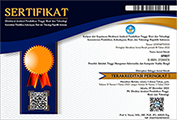SMISHING GUARD: STRATEGI PENGEMBANGAN SISTEM DETEKSI DAN RESPONS ANCAMAN SMS PHISHING
Abstract
Keywords
Full Text:
PDF hlm 12 - 23References
K. Y. Chai and M. F. Zolkipli, “Review on Confidentiality, Integrity and Availability in Information Security,” Journal of ICT In Education, vol. 8, no. 2, pp. 34–42, 2021, doi: 10.37134/jictie.vol8.2.4.2021.
S. Slamet, “Pertahanan Pencegahan Serangan Social Engineering Menggunakan Two Factor Authentication (2Fa) Berbasis Sms (Short Message System),” Spirit, vol. 14, no. 2, pp. 23–29, 2023, doi: 10.53567/spirit.v14i2.260.
A. A. C.Meenakshi, “SmishSMS- The Latest Detection of SMS Phishing Trends,” Tuijin Jishu/Journal of Propulsion Technology, vol. 44, no. 4, pp. 796–806, 2023, doi: 10.52783/tjjpt.v44.i4.936.
Id-SIRTII /CC, “Lanskap Keamanan Siber Indonesia,” Id-SIRTII /CC, no. 70, pp. 1–107, 2023.
Federal Trade Commission, “Annual Performance Report for Fiscal Year 2022 and Annual Performance Plan for Fiscal Years 2023 to 2024,” 2023, [Online]. Available: https://www.ftc.gov/system/files/ftc_gov/pdf/p859900fy22apr_fy23-24app.pdf.
S. Pokhrel, “Annual Review 2024,” Αγαη, vol. 15, no. 1, pp. 37–48, 2024.
B. Reaves, N. Scaife, D. Tian, L. Blue, P. Traynor, and K. R. B. Butler, “Sending Out an SMS: Characterizing the Security of the SMS Ecosystem with Public Gateways,” Proceedings - 2016 IEEE Symposium on Security and Privacy, SP 2016, pp. 339–356, 2016, doi: 10.1109/SP.2016.28.
E. N. Ekwonwune and V. C. Enyinnaya, “Design and Implementation of End to End Encrypted Short Message Service (SMS) Using Hybrid Cipher Algorithm,” Journal of Software Engineering and Applications, vol. 13, no. 03, pp. 25–40, 2020, doi: 10.4236/jsea.2020.133003.
O. Corporation, “Oracle ® Communications Convergent Charging Controller SMS Center Technical Guide,” no. October, 2023.
S. M. Peer-to-peer and P. Specification, “Short Message Peer-to-Peer Protocol Specification Version 5.0,” 2023, [Online]. Available: www.smsforum.net.
H. O. Lasisi, O. Oladepo, T. T. Awofolaju, and K. G. Olalekan, “Enhancement of Signaling System Number 7 for Improved Quality of Service in Mobile Communication Network,” vol. 6, no. 1, pp. 197–204, 2023.
A. J. Kouam, A. C. Viana, and A. Tchana, “SIMBox Bypass Frauds in Cellular Networks: Strategies, Evolution, Detection, and Future Directions,” IEEE Communications Surveys and Tutorials, vol. 23, no. 4, pp. 2295–2323, 2021, doi: 10.1109/COMST.2021.3100916.
D. C. Dewi, V. Y. Utami, and S. Y. M. Yusuf, “Peningkatan Kinerja Aparatur Melalui Sistem Informasi SHORT MESSAGE SERVICES (SMS) GATEWAY Pada Dinas Penanaman Modal dan Pelayanan Terpadu Satu Pintu Kota Makassar,” Ranah Publik Indonesia Kontemporer, vol. 1, no. 2, pp. 1–12, 2021.
R. Zieni, L. Massari, and M. C. Calzarossa, “Phishing or Not Phishing? A Survey on the Detection of Phishing Websites,” IEEE Access, vol. 11, no. January, pp. 18499–18519, 2023, doi: 10.1109/ACCESS.2023.3247135.
W. Li, S. Manickam, S. U. A. Laghari, and Y. W. Chong, “Uncovering the Cloak: A Systematic Review of Techniques Used to Conceal Phishing Websites,” IEEE Access, vol. 11, no. June, pp. 71925–71939, 2023, doi: 10.1109/ACCESS.2023.3293063.
B. Tejaswi, N. Samarasinghe, S. Pourali, M. Mannan, and A. Youssef, “Leaky Kits: The Increased Risk of Data Exposure from Phishing Kits,” eCrime Researchers Summit, eCrime, vol. 2022-Novem, 2022, doi: 10.1109/eCrime57793.2022.10142092.
T. Mynttinen, “Long Tran DATA SCRAPING APPLICTION WITH SCRAPY,” 2023.
B. Improve, “VirusTotal Enterprise,” 2021.
T. Gerbet and A. Kumar, “On the ( In ) security of Google Safe Browsing,” pp. 1–20, 2022.
E. B. Blancaflor, A. B. Alfonso, K. N. U. Banganay, G. A. B. D. Cruz, K. E. Fernandez, and S. A. M. Santos, “Let’s Go Phishing: A Phishing Awareness Campaign Using Smishing, Email Phishing, and Social Media Phishing Tools,” Proceedings of the International Conference on Industrial Engineering and Operations Management, no. Sanchez 2020, pp. 260–269, 2021, doi: 10.46254/ap01.20210108.
N. A. F. ICHIDA, “Optimasi Algoritma Simplified Lesk Dengan Spacy Untuk Word Sense Disambiguation Pada Kalimat Bahasa Inggris,” Jurnal Khatulistiwa Informatika, vol. 12, no. 1, pp. 13–18, 2024, doi: 10.31294/jki.v12i1.21404.
N. Nystrom, M. R. Clarkson, and A. C. Myers, “Polyglot: An extensible compiler framework for Java,” Lecture Notes in Computer Science (including subseries Lecture Notes in Artificial Intelligence and Lecture Notes in Bioinformatics), vol. 2622, pp. 138–152, 2003, doi: 10.1007/3-540-36579-6_11.
DOI: http://dx.doi.org/10.53567/spirit.v17i1.380
Refbacks
- There are currently no refbacks.
Copyright (c) 2025 Slamet Slamet

This work is licensed under a Creative Commons Attribution 4.0 International License.
Diindeks Oleh:
SPIRIT : Sarana Penunjang Informasi Terkini
Diterbitkan oleh Teknologi Informasi Institut Teknologi dan Bisnis Yadika Pasuruan
Alamat Redaksi: Jl. Bader No.9, Kwangsan, Kalirejo, Kec. Bangil, Pasuruan, Jawa Timur 67153
Telp/Fax: (0343) 742070 , Email : lppm@stmik-yadika.ac.id
Google Maps : Klik Disini

Karya ini dilisensikan di bawah Lisensi Internasional Creative Commons Atribusi 4.0 .







1.png)







